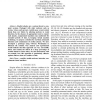114 search results - page 2 / 23 » Using Verification Technology to Specify and Detect Malware |
COMPSEC
2008
13 years 4 months ago
2008
Abstract-- Rootkit attacks are a serious threat to computer systems. Packaged with other malware such as worms, viruses and spyware, rootkits pose a more potent threat than ever be...
IMC
2006
ACM
13 years 10 months ago
2006
ACM
Peer-to-peer (P2P) networks continue to be popular means of trading content. However, very little protection is in place to make sure that the files exchanged in these networks a...
RAID
2009
Springer
13 years 11 months ago
2009
Springer
Due to the rapid advancement of mobile communication technology, mobile devices nowadays can support a variety of data services that are not traditionally available. With the growi...
AOSD
2009
ACM
13 years 11 months ago
2009
ACM
e is an aspect-oriented hardware verification language that is widely used to verify the design of electronic circuits through the development and execution of testbenches. In rec...
ICONIP
2009
13 years 2 months ago
2009
Malware (Malicious Software) of Windows OS has become more sophisticated. To take some countermeasures for recent infection, more intelligent and automated system log analysis is n...

